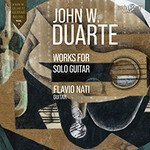
Duarte: Works for Solo Guitar
 $25.00
Out of Stock
$25.00
Out of Stock6+ weeks add to cart
JOHN DUARTE
Duarte: Works for Solo Guitar
Flavio Nati (guitar)
[ Brilliant Classics / CD ]
Release Date: Friday 2 February 2024
This item is currently out of stock. It may take 6 or more weeks to obtain from when you place your order as this is a specialist product.
Duarte's Partita was completed in 1974. It's a substantial work in four movements, using all original material. As in the Variations on a Theme of Štěpán Rak he adopts a four-note motif, which may be heard forwards, backwards, inverted and stretched. Variations on an Italian Folk Song Op.139 was written in 2000. It draws on the second movement, "Canzona", of Duarte's prior Suite piemontese, which was based on a combination of two tunes: Il testamento dell'avvelenato and Re Gilardin. This gentle theme is characterised by simple movements of a step or a fourth. The six variations all begin with this stepwise movement but they quickly gain individual characters.
Valse lyrique (2000) is one of the three short dances Duarte wrote late in his career. The second theme, clearly derived from the first, includes some hemiolas as well as combined harmonics and natural notes. The central section features the melody in the bass. Valse en rondeau was written in 1997 for the American guitarist David Starobin. Duarte stated: "I decided to make reference to my origin as a jazz musician and to my interest in early music (the Rondeau form) and to exercise my unshakeable belief in melody."
The origin of the Variations on a Theme of Štěpán Rak Op.100 is unique. In 1984 Rak was staying with Duarte when Vladimir Mikulka performed a lunchtime concert in London. At the end of the concert Mikulka announced that he was going to perform an unusual encore - a theme, but without variations that had yet to be written. Afterwards he announced that Rak, Koshkin and Duarte should exchange themes with each other to create six new variation works, and he presented Duarte with Rak's theme on a piece of manuscript paper. Andrés Segovia, a supreme Anglophile, married his third wife in Gibraltar ("under the British flag, on Spanish soil"), and their son was born in London.
Duarte's 3 Songs without Words for Carlos Andrés were a present to the happy couple. Danza eccentrica (2000) was dedicated to the Italian guitarist Domenico Lafasciano with the note, "Here is your dance. It may not be what you expected, but it's what I've written - not another 'cloned' rumba, tango, waltz or whatever, but something with more individual character." The unexpected aspects include dissonant harmonies, bass notes which move in ¾ against the treble in 6/8 and sections more reminiscent of a hurdy-gurdy.
The Italian guitarist Angelo Gilardino wrote to Duarte about his Fantasia and Fugue on Torre Bermeja Op.30: "…the melodic and rhythmic feeling is of the sort to easily produce the fascination of the public". The Torre Bermeja in question is the piano piece by Isaac Albéniz, Op.92 No.12. Although it carries Op.62 (1974) on its cover, the little Prélude en arpèges was written in 1954/5 and intended as the first movement of a Harp Suite Op.18 that was never completed.
Tracks:
Partita, Op. 59
Variations on an Italian Folk Song, Op. 139
Valse lyrique, Op. 137
Valse en rondeau, Op. 128
Variations on a Theme of Štĕpán Rak, Op. 100
3 Songs without Words for Carlos Andrés, Op. 45
Danza eccentrica, Op. 138
Fantasia and Fugue on Torre Bermeja, Op. 30
Prélude en arpèges, Op. 62